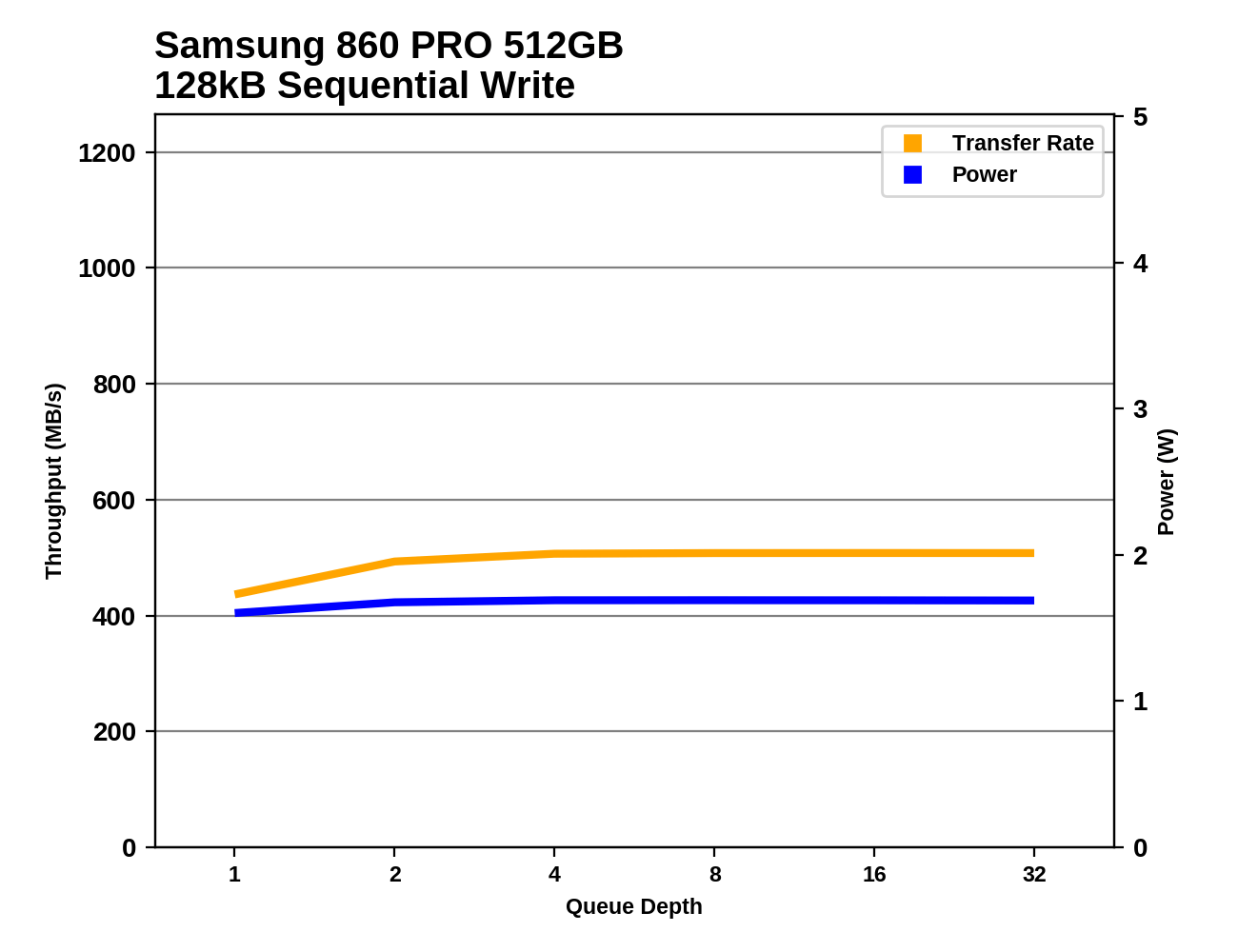The Samsung 860 PRO (512GB And 4TB) SSD Review: Replacing A Legend
by Billy Tallis on January 23, 2018 10:00 AM ESTSequential Read Performance
Our first test of sequential read performance uses short bursts of 128MB, issued as 128kB operations with no queuing. The test averages performance across eight bursts for a total of 1GB of data transferred from a drive containing 16GB of data. Between each burst the drive is given enough idle time to keep the overall duty cycle at 20%.

The burst sequential read speeds of the 860 PROs are good but not record setting, and the differences between the SATA drives are all dwarfed by the performance of the NVMe drive.
Our test of sustained sequential reads uses queue depths from 1 to 32, with the performance and power scores computed as the average of QD1, QD2 and QD4. Each queue depth is tested for up to one minute or 32GB transferred, from a drive containing 64GB of data.

With the exception of the 500GB 850 EVO, all of the Samsung SATA drives in this bunch offer about the same sustained sequential read speed. These drives have a substantial advantage over the competing drives, which are led by the Intel 545s at about 85 MB/s slower than the 860 PRO.

The two Samsung 860 PROs have the clear lead for power efficiency during sequential reads, above even the fast PM981 NVMe drive.
 |
|||||||||
The sequential read speed of the Samsung 860 PROs starts out quite close to the SATA limit, but they don't actually reach it until QD4. After that point, they are completely steady while the competing drives tend to be both slower and less consistent.
Sequential Write Performance
Our test of sequential write burst performance is structured identically to the sequential read burst performance test save for the direction of the data transfer. Each burst writes 128MB as 128kB operations issued at QD1, for a total of 1GB of data written to a drive containing 16GB of data.

Both models of the Samsung 860 PRO show a bit of a regression on the burst sequential write test, with the 4TB 860 PRO coming in at 13 MB/s slower than the 4TB 850 EVO, and the 512GB 860 PRO is behind the 512GB 850 PRO by twice that margin.
Our test of sustained sequential writes is structured identically to our sustained sequential read test, save for the direction of the data transfers. Queue depths range from 1 to 32 and each queue depth is tested for up to one minute or 32GB, followed by up to one minute of idle time for the drive to cool off and perform garbage collection. The test is confined to a 64GB span of the drive.

The sustained sequential write speeds of the Samsung 860 PRO are slightly lower than some of the 850s, but not noticeably. Only the Intel 545s and SanDisk Ultra 3D are slow enough to really care about.

The power efficiency of the 860 PRO continues to be a huge improvement over the 850s, with the 512GB 860 PRO taking a big lead over everything else in its class.
 |
|||||||||
Most of the SATA drives are at full speed by QD2 or QD4, but the SanDisk Ultra 3D takes a bit longer to get up to speed and the Crucial MX300 can't maintain that speed. Once they've all (mostly) plateaued at the same performance level, it is clear that the 860 PRO requires less power than any of its competitors or predecessors.










64 Comments
View All Comments
StevoLincolnite - Wednesday, January 24, 2018 - link
Or. We could finally transition to Sata 3.3 which offers 1,900MB/s.PixyMisa - Wednesday, January 24, 2018 - link
SATA Express is dead. U.2 is twice as fast and better supported.I'd like to see internal drives move to USB-C. Better connector, faster, universally supported, and any internal drive just works as an external drive.
Would need USB RAID controllers though.
peevee - Tuesday, January 30, 2018 - link
You mean 3.2, SATA Express, with 2 PCI Express lines? Seems like it is the past, U.2 superseding it.Roen - Saturday, March 10, 2018 - link
SATA Express has been a non-starter and DOA.This is why people use M.2, U.2 and other non-SATA PCIe interfaces.
Roen - Saturday, March 10, 2018 - link
M.2 NVMe I should be more specific.Roen - Saturday, March 10, 2018 - link
PCIe 3.0 x4 beats PCIe 3.0 x2 from SATA 3.2Gastec - Thursday, January 25, 2018 - link
I have an 8 year old PC that was designed from the start without an internal DVD drive as I had no need for one, having used an external USB DVD unit since like 2009. I have not plugged in the external DVD for more than a year, maybe two years. The PC sports 2 SSDs (one for the OS and the other for games) and only one old and annoying HDD that I seriously consider replacing with a SSD to have a more relaxed, vibration-free computing experience. I this day and age a computer enthusiast is more stressed than ever and values a quiet, vibration-free system. So the HDD must go!appliance5000 - Thursday, January 25, 2018 - link
What are DVDs?chrcoluk - Friday, April 12, 2019 - link
unless ssd's can match spindles price per gig, then yes sata will most definitely still be around in 5 years as its what powers spindle drives. Also good luck in finding boards that support 8 nvme devices.generaldwarf - Tuesday, January 23, 2018 - link
And the mx500 is the new king of TLC, less expensive than the evo for the same thing.